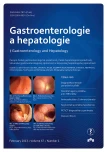18FDG-PET/CT diagnostics of pancreatic adenocarcinoma
Authors:
P. Fencl
Authors‘ workplace:
ONM-PET centrum, Nemocnice Na Homolce, Praha
Published in:
Gastroent Hepatol 2013; 67(1): 45-48
Category:
Gastrointestinal Oncology: Review Article
Overview
Nowadays, high-resolution scanners are used for 18FDG-PET/CT examination, reaching adiagnostic accuracy of 90% to 95%, to diagnose pancreatic cancer. The advantage of the method is the whole-body examination range, which enables reliable detection of remote bodies of disease generalisation thanks to the high sensitivity of metabolic information. Therefore, 18FDG-PET/CT examination should be included in the pre-surgery consideration as it can lead to higher relative savings of funds despite its higher price, as well as improve post-surgery outcomesby excluding from radical treatment those patients whose disease is generalised at the time of the diagnose.
Key words:
pancreatic cancer – positron emission tomography and computed tomography
The author declares he has no potential conflicts of interest concerning drugs, products, or services used in the study.
The Editorial Board declares that the manuscript met the ICMJE „uniform requirements“ for biomedical papers.
Submitted:
27. 10. 2012
Accepted:
5. 12. 2012
Sources
1. Lemke AJ, Niehues SM, Hosten N et al. Retrospective digital image fusion of multidetector CT and 18F-FDG PET: clinical value in pancreatic lesions – a prospective study with 104 patients. J Nucl Med 2004; 45(8): 1279–1286.
2. Casneuf V, Delrue L, Kelles A et al. Is combined 18F-fluorodeoxyglucose-positron emission tomography/computed tomography superior to positron emission tomography or computed tomography alone for diagnosis, staging and restaging of pancreatic lesions? Acta Gastroenterol Belg 2007; 70(4): 331–338.
3. Buchs NC, Bühler L, Bucher P et al. Value of contrast-enhanced 18F-fluorodeoxyglucose positron emission tomography/computed tomography in detection and presurgical assessment of pancreatic cancer: a prospective study. J Gastroenterol Hepatol 2011; 26(4): 657–662.
4. Strobel K, Heinrich S, Bhure U et al. Contrast-enhanced 18F-FDG PET/CT: 1-stop-shop imaging for assessing the resectability of pancreatic cancer. J Nucl Med 2008; 49(9): 1408–1413.
5. Sahani DV, Shah ZK, Catalano OA et al. Radiology of pancreatic adenocarcinoma: Current status of paging. J Gastroenterol Hepatol 2008; 23(1): 23–33.
6. Kysučan J, Loveček M, Klos D et al. Přínos PET/CT k předoperačnímu staging karciniomu pankreatu. Rozhl Chir 2010; 89(7): 433–440.
7. Buchs NC, Bühler L, Bucher P et al. Value of contrast-enhanced 18F-fluorodeoxyglucose positron emission tomography/computed tomography in detection and presurgical assessment of pancreatic cancer: a prospective study. J Gastroenterol Hepatol 2011; 26(4): 657–662.
8. Kitajima K, Murakami K, Yamasaki E et al. Performance of integrated FDG-PET//contrast-enhanced CT in the diagnosis of recurrent pancreatic cancer: comparison with integrated FDG-PET/non-contrast--enhanced CT and enhanced CT. Mol Imaging Biol 2010; 12(4): 452–459.
9. Reske SN, Kotzerke J. FDG-PET for clinical use. Results of the 3rd German Interdisciplinary Consensus Conference, “Onko-PET III”, 21 July and 19 September 2000. Eur J Nucl Med 2001; 28(11): 1707–1723.
10. Diederichs CG, Staib L, Glasbrenner B et al. F-18 Fluorodeoxyglucose (FDG) and C-Reactive Protein (CRP). Clin Positron Imaging 1999; 2(3): 131–136.
11. Johnson GC. Assessment and approval of medical devices used in diagnostic imaging in the United States. Isr J Med Sci 1986; 22(7–8): 505–518.
12. Bietendorf J. FDG PET reimbursement. J Nucl Med Technol 2004; 32(1): 33–38.
13. Berberat P, Friess H, Kashiwagi M et al. Diagnosis and staging of pancreatic cancer by positron emission tomography. World J Surg 1999; 23(9): 882–887.
14. Zimny M, Bares R, Fass J et al. Fluorine-18 fluorodeoxyglucose positron emission tomography in the differential diagnosis pf pancreatic carcinoma: a report of 106 cases. Eur J Nucl Med 1997; 24(6): 678–682.
15. Delbeke D, Rose DM, Chapman WC et al. Optimal interpretation of FDG PET in the diagnosis, staging and mangement of pancreatic carcinoma. J Nucl Med 1999; 40(11): 1784–1791.
16. Zimny M, Schlumpelick V. Fluordeoxyglucose positron emission tomography (FDG-PET) in the differential diagnosis of pancreatic lesions. Chirurg 2001; 72(9): 989–994.
17. Tang S, Huang G, Liu J et al. Usefulness of 18F-FDG PET, combined FDG-PET/CT and EUS in diagnosing primary pancreatic carcinoma: A meta-analysis. Eur J Radiol 2011; 78(1): 142–150.
18. Schick V, Franzius C, Beyna T et al. Diagnostic impact of 18F-FDG PET-CT evaluating solid pancreatic lesions versusendosonography, endoscopic retrograde cholangio-pancreatography with intraductalultrasonography and abdominal ultrasound. Eur J Nucl Med Mol Imaging 2008; 35(10): 1775–1785.
19. Kauhanen SP, Komar G, Seppänen MP et al. A Prospective Diagnostic Accuracy Study of 18F-Fluorodeoxyglucose Positron Emission Tomography/Computed Tomography, Multidetector Row Computed Tomography, and Magnetic Resonance Imaging in Primary Diagnosis and Staging of Pancreatic Cancer. Ann Surg 2009; 250(6): 957–963.
20. Wu LM, Hu JN, Hua J et al. Diagnostic value of diffusion-weighted magnetic resonance imaging (DWI) compared to FDG PET/CT for pancreatic malignancy: a meta-analysis using a hierarchical regression model. J Gastroenterol Hepatol 2012; 27(6): 1027–1035.
21. http://en.wikipedia.org/wiki/Diffusion_MRI.
22. Tanimoto K, Yoshikawa K, Obata T et al. Role of glucose metabolism and cellularity for tumor malignancy evaluation using FDG-PET/CT and MRI. Nucl Med Commun 2010; 31(6): 604–609.
23. Buck AK, Herrmann K, Stargardt T et al. Economic evaluation of PET and PET/CT in oncology: evidence and methodologic approaches. J Nucl Med Technol 2010; 38(1): 6–17.
24. Barber TW, Kalff V, Cherk MH et al. 18F-FDG PET/CT influences management in patients with known or suspected pancreatic cancer. Intern Med J 2011; 41(11): 776–783.
25. Heinrich S, Goerres GW, Schäfer M et al. Positron Emission Tomography/Computed Tomography Influences on the Management of Resectable Pancreatic Cancer and Its Cost-Effectiveness. Ann Surg 2005; 242(2): 235–243.
26. Delbeke D, Martin WH. PET and PET/CT for pancreatic malignancies. Surg Oncol Clin N Am 2010; 19(2): 235–254.
27. Sobin LH, Gospadorowicz MK, Wittekind C. TNM classification of malignant tumours. Chichester: John Wiley & Sons 2009.
Labels
Paediatric gastroenterology Gastroenterology and hepatology SurgeryArticle was published in
Gastroenterology and Hepatology

2013 Issue 1
Most read in this issue
- Segmental portal hypertension
- Current opinion on the therapy of perianal fistulas in patients with Crohn’s disease
- Perforated gangrenous cholecystitis
- Dysfunction of upper gastrointestinal tract in critically ill patients: current view and prospects
